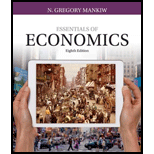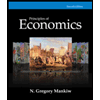
Sub part (a):
The nominal and real
Sub part (a):
Explanation of Solution
The GDP is the summation of the monetary value of all the goods and services produced within the political boundary of a country, within a financial year. There are two different ways of calculating the GDP of the economy and they are the real GDP and the nominal GDP. The real GDP is the GDP calculated at the constant prices. There will be a base
The nominal GDP of the economy can be calculated by multiplying the quantity produced by the per unit price of the commodity. The quantity produced and price in 2016 was 100 quarts of milk and 50 quarts of honey. The prices were $1 and $2 respectively, for each quart. Thus, the nominal GDP of 2016 can be calculated as follows:
Thus, the nominal GDP of 2016 is $200.
Similarly, the quantity produced and price in 2017 was 200 quarts of milk and 100 quarts of honey. The prices were $1 and $2, respectively. Thus, the nominal GDP of 2017 can be calculated as follows:
Thus, the nominal GDP of 2017 is $400.
Similarly, the quantity produced in 2018 was 200 quarts of milk and 100 quarts of honey but the prices increased to $2 and $4, respectively. Thus, the nominal GDP of 2018 can be calculated as follows:
Thus, the nominal GDP of 2018 is $800.
The real GDP can be calculated by multiplying the quantity produced with the base year price level. Since the base year is 2016, the nominal GDP of 2016 will be equal to the real GDP of 2016, which is equal to $200.
In the case of 2017, the real GDP can be calculated by multiplying the 2017 quantity with the 2016 price as follows:
Thus, the real GDP of 2017 is $400.
In the case of 2018, the real GDP can be calculated by multiplying the 2018 quantity with the 2016 price. Since there is no change in the quantity produced in 2018 and 2017 in the two commodities of milk and honey, there will be no change in the real GDP of the two years and thus, the real GDP of 2018 will be the same as 2017, which is $400.
The GDP deflator is the implicit price deflator. It can be calculated by dividing the nominal GDP with the real GDP and multiplying the value with 100 as follows:
Thus, by substituting the values of nominal and real GDP in the equation, we can calculate the GDP deflator as follows:
Thus, the GDP deflator in 2016 is 100. Similarly, the GDP deflator for 2017 can be calculated as follows:
Thus, the GDP deflator in 2017 is also 100.
The GDP deflator for 2018 can be calculated as follows:
Thus, the GDP deflator in 2018 is 200.
These values can be tabulated as follows:
Table 1
| Year | Nominal GDP | Real GDP | GDP Deflator |
| 2016 | $200 | $200 | 100 |
| 2017 | $400 | $400 | 100 |
| 2018 | $800 | $400 | 200 |
Concept introduction:
Gross Domestic Product (GDP): It is the summation of the monetary value of all the goods and services produced within the political boundary of a country, within a financial year.
GDP deflator: It is an implicit price deflator.
Sub part (b):
The Percentage change in nominal and real GDP and GDP deflator.
Sub part (b):
Explanation of Solution
The percentage change in nominal GDP can be calculated by the following formula:
Thus, by substituting the values for the current year and previous year, we can calculate the percentage change in the nominal GDP as follows:
Thus, the percentage change in nominal GDP of 2017 is 100 percent.
Thus, the percentage change in nominal GDP of 2018 is also 100 percent.
Similarly, the percentage change in real GDP and GDP deflator can be calculated as follows:
The percentage change in real GDP of 2017 is 100 percent.
The percentage change in real GDP of 2018 is 0 percent.
The percentage change in the GDP deflator can be calculated as follows:
Thus, the percentage change in GDP deflator of 2017 is 0 percent.
Thus, the percentage change in GDP deflator of 2018 is 100 percent.
The prices in the economy remain the same in the year 2016 and 2017, which leads to no change in the percentage change in the GDP deflator. This is why the GDP deflator percentage change is zero. Similarly, the output levels remain the same in the years 2017 and 2018, which leads to the value of percentage change in the real GDP to remain at zero.
Concept introduction:
Gross Domestic Product (GDP): It is the summation of the monetary value of all the goods and services produced within the political boundary of a country, within a financial year.
GDP deflator: It is an implicit price deflator.
Sub part (c):
Economic well-being.
Sub part (c):
Explanation of Solution
The economic well-being increased much larger in the year of 2017, when compared to 2016 and 2018. This result is obtained from the analysis of the data that the real GDP remained the same in 2018 as the real GDP in the 2017. Thus, there were no changes in the real GDP after 2017. But after 2016, the real GDP increased from $200 to $400 in 2017. This means that the well-being rose more in 2017. Another reason why the well-being didn’t rise in 2018 was the price hike. The output remained the same, whereas prices doubled.
Concept introduction:
Gross Domestic Product (GDP): It is the summation of the monetary value of all the goods and services produced within the political boundary of a country, within a financial year.
Want to see more full solutions like this?
Chapter 15 Solutions
Essentials of Economics (MindTap Course List)
- Using the grapns below, wnicn snow the snort-run cost curves for 3 perfectly competitive firms in the same industry, determine whether the industry is in long-run equilibrium or not. Q Q Firm A QA MC ATC Output Firm B QB MC ATC Firm C MC ATC Output Output Qc If Firms A, B and C are in the same industry, is this industry in long-run equilibrium? ○ A. Yes, because P = MC = MR for each of the 3 firms. ○ B. No, because Firm A is not producing at a profit-maximizing level of output. ○ C. Yes, because all 3 firms are producing at their minimum average total cost. OD. The answer is uncertain since it's unknown whether the firms are producing at the minimum efficient scale or not. ○ E. No, because if the industry were in equilibrium, all 3 firms would be earning zero economic profits.arrow_forwardConsider the table on the right, which shows the various revenue concepts for a perfectly competitive firm. Suppose the firm faces a constant market price of $4. Compute first total revenue for each level of output and fill in the TR column of the table. Next, compute marginal revenue for each level of output and fill in the MR column of the table. (Marginal revenue at each level of output is computed using total revenue for two successive levels of output. For example, marginal revenue at 160 uses total revenue for output levels 120 and 160.) Total Marginal Price (p)Quantity (Q) Revenue (TR)Revenue (MR) $4 A EA 120 $4 160 $4 200 $4 240 $4 280 $ EA EA EA 10 S คarrow_forwardThis week we will be discussing measures of economic well-being. Read the following short article from the Office of National Statistics from the U.K. which discusses different measures of economic well-being: https://blog.ons.gov.uk/2017/07/06/beyond-gdp-measuring-the-economic-well-being-of-individuals/ For this assignment, we will narrow down to the economic well-being of the St. Louis region (or another region you choose). As the article indicates there are different measures of well-being. You are interested in creating a Hypothesis Test about the economic well-being of the area. Discuss the following issues: First, think about your research hypothesis and justify it briefly. Remember, a hypothesis is a well-thought and untested proposition. What is the null hypothesis? What is the parameter you are interested in? (i.e., the measure of well-being). Is it going to be a Lower-Tail, Upper-Tail or Two-Tailed test? What is the data that you need and how will you collect the data? What…arrow_forward
- Johnny brought $39.50 to the art supply store. He bought a brush, a sketchbook, and a paint set. The brush was 1 6 as much as the sketchbook, and the sketchbook cost 3 4 the cost of the paint set. Johnny had $2.00 left over after buying these items.arrow_forwardA young woman plans to retire early in 25 years. She believes she can save $10,000 each year starting now. If she plans to begin withdrawing money one year after she makes her last payment into the retirement account (i.e., in the 26th year), what uniform amount could she withdraw each year for 30 years, if the account earns an interest rate of 8% per year? a) Correctly plot the cash flow diagram with its respective vectors, arrowheads, units, and currency values. b) Correct mathematical approach and development, use of compound interest factors.c) Financial logic in the development of the exercise and application of the concept of time value of money. d) Final numerical answer and writing in prose with a minimum of 20 words and a maximum of 50 words of the obtained numerical interpretation.arrow_forwardA hospital charges $200 for a medical procedure, and 1,000 patients use the service. The hospital raises the price to $250, and the number of patients drops to 900. Calculate the price elasticity of demand (PED) and explain your answer. (show all working) Briefly explain how elasticity affects government health policies in the following cases: • Taxes on unhealthy products (cigarettes, alcohol, sugary drinks) • Subsidizing Preventive Care (e.g., vaccines, screenings) Drug Price Controls & Generic Substitutions Co-Payments & Insurance Designarrow_forward
- Assume the United States is a large consumer of steel, able to influence the world price. DUS and SUS denote its demand and supply schedules in Figure 1. The overall (United States plus world) supply schedule of steel is denoted by SUS.+W. Figure 1 Import Tariff Levied by a Large Country Answer all questions (a-f) by referring to Figure 1 above. a) Calculate the free trade market equilibrium price, domestic consumption, and volumE Answer all questions (a-f) by referring to Figure 1 above. a) Calculate the free trade market equilibrium price, domestic consumption, and volume of steel imports by the US. [5 marks] b) Suppose the United States imposes a tariff (t) of $100 on each ton of steel imported. With the tariff, calculate the price of steel and the volume of steel imports by the US. [5 marks] c) Of the $100 tariff, how much is passed on to the US consumer via a higher price, and how much is borne by the foreign exporter? [5 marks] d) Calculate the tariff's deadweight welfare loss to…arrow_forward1. A doctor quits his job, which pays $77,000 per annum, to open a non-governmental organization (NGO) to serve the needs of orphans. His annual expenses for the NGO amounts to $62,700 for food and daily supplies, $9,400 for maintenance, and $1,800 for books. What is his opportunity cost of opening the NGO? (Show working) 2. During the COVID-19 pandemic, hospitals worldwide faced severe resource constraints, including: a. Limited ICU beds b. Shortage of ventilators c. Insufficient doctors and nurses d. Lack of vaccines in early 2021 Governments and hospitals had to make critical decisions about who receives treatment first and how to allocate limited resources efficiently. In no more than 150 words and using core economic concepts of scarcity, choice and opportunity cost, how would you help your government make these critical decisions?arrow_forwardWhat is the argument about necessary evil?arrow_forward
- What are the consequences of declining houses prices?arrow_forwardQ1 Explain what economic catch 22 is. Q2 What are the consequences of declining houses pricing? Q3 What is the argument about necessary evil? Q4 Explain the idea of irrational exhuberance? Q5 Explain what was the economic paradox?arrow_forward< Files 9:10 Fri Mar 21 Chapter+11-Public+Goods+and+Common+Res... The Economic Catch-22 By Robert J. Samuelson We are now in the "blame phase" of the economic cycle. As the housing slump deepens and financial markets swing erratically, we've embarked on the usual search for culprits. Who got us into this mess? Our investigations will doubtlessly reveal, as they already have, much wishful thinking and miscalculation. They will also find incompetence, predatory behavior and probably some criminality. But let me suggest that, though inevitable and necessary, this exercise is also simplistic and deceptive. -- business It assumes that, absent mistakes and misdeeds, we might remain in a permanent paradise of powerful income and wealth growth. The reality, I think, is that the economy follows its own Catch-22: By taking prosperity for granted, people perversely subvert prosperity. The more we managers, investors, consumers - think that economic growth is guaranteed and that risk and…arrow_forward
 Economics (MindTap Course List)EconomicsISBN:9781337617383Author:Roger A. ArnoldPublisher:Cengage Learning
Economics (MindTap Course List)EconomicsISBN:9781337617383Author:Roger A. ArnoldPublisher:Cengage Learning
 Macroeconomics: Principles and Policy (MindTap Co...EconomicsISBN:9781305280601Author:William J. Baumol, Alan S. BlinderPublisher:Cengage Learning
Macroeconomics: Principles and Policy (MindTap Co...EconomicsISBN:9781305280601Author:William J. Baumol, Alan S. BlinderPublisher:Cengage Learning Principles of Economics, 7th Edition (MindTap Cou...EconomicsISBN:9781285165875Author:N. Gregory MankiwPublisher:Cengage Learning
Principles of Economics, 7th Edition (MindTap Cou...EconomicsISBN:9781285165875Author:N. Gregory MankiwPublisher:Cengage Learning Essentials of Economics (MindTap Course List)EconomicsISBN:9781337091992Author:N. Gregory MankiwPublisher:Cengage Learning
Essentials of Economics (MindTap Course List)EconomicsISBN:9781337091992Author:N. Gregory MankiwPublisher:Cengage Learning Principles of Economics (MindTap Course List)EconomicsISBN:9781305585126Author:N. Gregory MankiwPublisher:Cengage Learning
Principles of Economics (MindTap Course List)EconomicsISBN:9781305585126Author:N. Gregory MankiwPublisher:Cengage Learning





